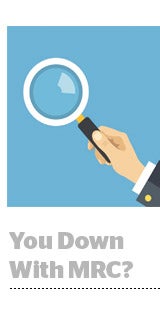When it comes to third-party verification, the big digital platforms like Facebook and Google have reason to rush. They’re working on deadline.
Marc Pritchard, P&G’s chief brand officer, has made it clear platforms need to implement Media Ratings Council-accredited third-party viewability measurement by the end of the year or risk losing the CPG giant’s business.
And it’s not just P&G. An Association of National Advertisers survey in March found that 89% of its members want independent MRC audits for the big digital platform players.
The threats to withhold ad dollars appear to be resonating.
This is what the walled gardens have agreed to thus far.
Facebook’s claim that an ad impression has value as long as any pixels are in view to a human for any length of time didn’t sit well with big media buyers.
GroupM in particular took issue with the leniency of that definition and decried the notion of a fox guarding its own henhouse.
Conceding to pressure, Facebook made its first material overture to openness in 2015 when it partnered with third-party verification vendor Moat to measure video ads, first on Facebook and then on Instagram.
It later added Integral Ad Science and comScore as video viewability measurement partners across Facebook, Instagram and Audience Network.
Then, Facebook added display viewability on Facebook with IAS, Moat and comScore, and is in the process of integrating with DoubleVerify for video and display. In March, Facebook partnered with European ad verification firm Meetrics to measure the delivery of display and video ads across Facebook and Instagram.
Facebook measures reach and in-target audience through Nielsen’s Digital Ad Ratings and comScore’s validated Campaign Essentials.
After Facebook admitted to a series of reporting errors in September – including overestimating video ad view time, the number of people visiting Pages and time spent reading Instant Articles – the social network formed a Measurement Council in November to facilitate dialogue with its buy-side partners on measurement product development and standards.
Facebook’s largest concession to independent measurement came in February, when it agreed to an MRC audit of its served ad impressions across video and display. But that’s actually different from what P&G and its buy-side brethren are asking for, which is verification for viewable impressions on Facebook as defined by the MRC. Once the served impression audit is complete, Facebook reportedly will seek the MRC’s blessing for viewable impressions.
In the meantime, Facebook introduced a number of conciliatory buying options for its advertisers, including the ability to purchase video on completed views or to only pay when a video is viewed with the sound on. Advertisers can also buy on two-second views, as per the MRC’s video standard.
Facebook also maintains more than 20 third-party measurement relationships for multitouch attribution, marketing-mix modeling and app measurement with a slew of partners, including Acxiom, adjust, AppsFlyer, ApsalarMillward Brown, Kantar Worldpanel, Kochava, Neustar Marketshare, Nielsen Catalina Solutions, Oracle Data Cloud and Visual IQ.
Although the MRC accredited Google’s ad-server-based viewability solution, Active View, in 2014, industry heavies like Unilever and Kellogg’s kept gunning for independent third-party verification. The following year, Google integrated with Integral Ad Science, Moat, DoubleVerify and comScore to report on viewability for ads served on YouTube.
In February, Google said it would allow the MRC to audit each of its third-party viewability integrations to validate that the data transfer and reporting align with MRC and IAB standards.
As for why Google feels the need to audit it third-party viewability partnerships when IAS, Moat, DoubleVerify and comScore already have MRC accreditation, Google argued that its scale coupled with its privacy and security requirements requires more scrutiny than a run-of-the-mill integration.
It’s also the first time Google is letting the MRC audit YouTube metrics. Although Active View, which is available for YouTube, DoubleClick, AdMob and the Google Display Network, is MRC-accredited, the council has never directly audited YouTube measurement.
At the same time, Google announced that it would transition away from counting served impressions in DoubleClick for Publishers to only counting an impression when an ad starts loading on a page, as per updated measurement guidelines released by the IAB and MRC last year.
But despite getting its viewability ducks in a row and throwing its support behind an initiative to create an open-source SDK for in-app viewability, Google is still racing to manage the fallout from its brand-safety blunders.
In early April, Google said it would work with MRC-accredited companies for brand-safety reporting on YouTube. Google hasn’t released the full list of the vendors it’s working with, although Integral Ad Science, comScore and DoubleVerify made the cut.
In 2015, Twitter rolled out autoplay video and a new definition of viewability on the platform: 100% in view for at least three seconds, which goes beyond the MRC baseline requirement of 50% of a video player’s pixels in view for a minimum of two seconds.
If a Promoted Video or GIF isn’t fully in view for three continuous seconds, the advertiser doesn’t pay.
But Twitter was late to the game in terms of third-party measurement partnerships. It was only in April that Twitter hooked up with Moat and Integral Ad Science to measure video viewability and attention metrics, like hover rates and scroll velocity.
In April, Twitter also claimed to be in “ongoing conversations with organizations like the Media Ratings Council on the accreditation process,” but there’s no concrete news on whether Twitter will follow the duopoly’s lead with an independent MRC audit of its own.
Nielsen and comScore enable audience verification metrics for Twitter, including reach, frequency and demographics.
Snapchat
Back in 2015, when Snapchat first started selling ads, buyers were dazzled by the shininess of the platform’s object, but less than enthused with its lack of third-party measurement partnerships.
In January, a former employee filed a lawsuit against Snapchat, alleging that the company misrepresented its user growth numbers ahead of its IPO. While not a viewability issue, news like that calls into question Snapchat’s ability to truthfully self-report.
Although Snapchat’s vertical video unit is arguably always in view because it takes over the whole screen, advertisers were concerned Snapchat was charging for views of less than one second. In mid-2016, Snapchat partnered with Moat to measure viewability and audibility across all Snapchat video ad impressions.
Snapchat also maintains third-party partners to measure reach and frequency data, including Nielsen, Google’s DoubleClick, Sizmek, Innovid and Millward Brown Digital.
Ad buyers are pushing for Snapchat to undergo an MRC audit, especially in light of its recent IPO, but Snapchat hasn’t intimated when or whether that’s in the cards.
Moat has been Pinterest’s preferred partner for viewability and attention analytics across the platform since late 2016.
A partnership with Millward Brown aims to help advertisers understand how Promoted Pins impact KPIs like awareness, purchase intent and favorability.
Although a Pinterest spokesperson told AdExchanger that the platform is in conversations with the MRC about an audit, there’s no timeline for when one might occur.
Pandora
Although Pandora isn’t usually classed as a walled garden in the same category as Facebook and Google, et al., P&G’s Pritchard did name drop the platform during his now infamous IAB Leadership Meeting speech in January.
Moat became Pandora’s preferred viewability partner in 2014 for display and video, including the audibility of video ads. Last year, the music-streaming platform extended its partnership with Moat to include 100% in-view ads across in-app environments. Inventory is available to buy on a cost-per-viewable-impression basis.
Pandora also is in the early phases of development for an internal metric to measure the audibility of audio ads.
Beyond viewability and audibility, Pandora maintains the usual battery of de rigueur third-party partnerships for brand lift, location analytics and closed-loop attribution studies, including with Millward Brown Digital and Foursquare.
Triton Digital, an MRC-accredited company that builds ad tech for digital and broadcast radio, is Pandora’s primary partner to validate its registration data and measure its audience and listening hours.
However, a Pandora spokesperson told AdExchanger that the platform is in conversations with the MRC and Ernst & Young about possibly getting accredited to measure its own audience data.
















